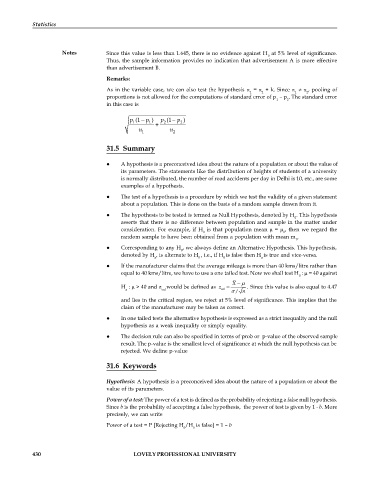Page 438 - DMTH404_STATISTICS
P. 438
Statistics
Notes Since this value is less than 1.645, there is no evidence against H at 5% level of significance.
0
Thus, the sample information provides no indication that advertisement A is more effective
than advertisement B.
Remarks:
As in the variable case, we can also test the hypothesis = + k. Since , pooling of
1 2 1 2
proportions is not allowed for the computations of standard error of p – p . The standard error
1 2
in this case is
-
-
p (1 p ) p (1 p )
1 1 2 2
+
n n
1 2
31.5 Summary
A hypothesis is a preconceived idea about the nature of a population or about the value of
its parameters. The statements like the distribution of heights of students of a university
is normally distributed, the number of road accidents per day in Delhi is 10, etc., are some
examples of a hypothesis.
The test of a hypothesis is a procedure by which we test the validity of a given statement
about a population. This is done on the basis of a random sample drawn from it.
The hypothesis to be tested is termed as Null Hypothesis, denoted by H . This hypothesis
0
asserts that there is no difference between population and sample in the matter under
consideration. For example, if H is that population mean = , then we regard the
0 0
random sample to have been obtained from a population with mean m .
0
Corresponding to any H , we always define an Alternative Hypothesis. This hypothesis,
0
denoted by H , is alternate to H , i.e., if H is false then H is true and vice-versa.
a 0 0 a
If the manufacturer claims that the average mileage is more than 40 kms/litre rather than
equal to 40 kms/litre, we have to use a one tailed test. Now we shall test H : = 40 against
0
-
X
H : > 40 and z would be defined as z = . Since this value is also equal to 4.47
a cal cal
s / n
and lies in the critical region, we reject at 5% level of significance. This implies that the
claim of the manufacturer may be taken as correct.
In one tailed tests the alternative hypothesis is expressed as a strict inequality and the null
hypothesis as a weak inequality or simply equality.
The decision rule can also be specified in terms of prob or p-value of the observed sample
result. The p-value is the smallest level of significance at which the null hypothesis can be
rejected. We define p-value
31.6 Keywords
Hypothesis: A hypothesis is a preconceived idea about the nature of a population or about the
value of its parameters.
Power of a test: The power of a test is defined as the probability of rejecting a false null hypothesis.
Since b is the probability of accepting a false hypothesis, the power of test is given by 1 - b. More
precisely, we can write
Power of a test = P [Rejecting H /H is false] = 1 – b
0 0
430 LOVELY PROFESSIONAL UNIVERSITY

